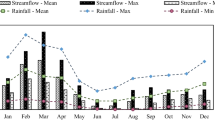Abstract
High loads of suspended sediment derived from surface water erosion processes are a major source of environmental and economic problems throughout the world. In many places, a reduction in the amount of sediment delivered from arable land to rivers has therefore become a major issue in environmental policy. In Flanders (Belgium), policy makers would like to achieve a reduction in soil erosion and sediment delivery through the use of various control measures adopted under an integrated environmental watershed management program. A distributed modelling approach (SEDEM/WaTEM) showed that although end-of-the-pipe solutions such as buffer strips or sediment retention ponds have a direct impact on sediment delivery, on-site soil conservation measures were more effective in reducing sediment loads in rivers. It remains questionable, however, whether the significant impact that watershed management has on local sediment yields, can be extrapolated to larger river drainage basins. In the case of highly regulated and channelized rivers, the impact may be much higher compared to natural rivers.
Similar content being viewed by others
References
AMINAL, 2002. Wegwijzer Doorheen het Erosiebesluit; Subsidies Voor Plannen en Werken. Infobrochure van Het Ministerie van de Vlaamse Gemeenschap, Afdeling Land, Brussel (in Dutch).
Dillaha, T. A., R. B. Reneau, S. Mostaghimi & D. Lee, 1989. Vegetative filter strips for agricultural non point source pollution. Trans. ASAE 32: 513-519.
Evans, J. K., J. F. Gottgens, W. M Gill & S. D. Mackey 2000. Sediment yields controlled by intrabasinal storage and sediment conveyance over the interval 1842-1994: Chagrin River, Northeast Ohio, U.S.A. J. Soil Wat. Conserv. 55: 264-270.
Ferro, V. & M. Minacapilli, 1995. Sediment delivery processes at basin scale. Hydrol. Sci. J. 40: 703-717.
Goudie, A., 1981. The Human Impact: Man's Role in Environmental Change. MIT Press, Cambridge, Massachusetts, U.S.A., 316 pp.
Haan, C. T., B. J. Barfield & J. C., Hayes, 1994. Design hydrology and sedimentology for small catchments. Academic Press, San Diego, CA, U.S.A.
Philips, J. D., 1993. Pre-and post-colonial sediment sources and storage in the lower Neuse basin, North Carolina. Phys. Geogr. 16: 272-284.
Poesen, J., G. Govers & D., Goossens, 1996. Verdichting en erosie van de bodem in Vlaanderen (Soil erosion and compaction in Flanders). Tijdschrift van de Belg. Ver. Aardr. Studies - BEVAS 2: 141-181 (in Dutch).
Trimble, S.W., 1999. Decreased rates of alluvial sediment storage in the Coon Creek Basin, Wisconsin, 1975-93. Science 285: 1244- 1246.
Van Dijk, P. M., F. J. P. M. Kwaad & M. Klapwijk, 1996. Retention of water and sediment by grass strips. Hydrol. Proc. 10: 1069-1080.
Van Oost, K., G. Govers & P. J. J., Desmet, 2000. Evaluating the effects of changes in landscape structure on soil erosion by water and tillage. Landscape Ecol. 15: 579-591.
Van Rompaey, A., G. Verstraeten, K. Van Oost, G. Govers & J. Poesen, 2001a. Modelling mean annual sediment yield using a distributed approach. Earth Surface Processes and Landforms 26: 1221-1236.
Van Rompaey, A., G. Govers, E. Van Hecke & K. Jacobs, 2001b. The impacts of land use policy on the soil erosion risk: a case study in central Belgium. Agric. Ecosyst. Environ. 83: 83-94.
Verlaan, P. A. J., 2000. Marine vs fluvial bottom mud in the Sheldt Estuary. Estuar. coast. shelf Sci. 50: 627-638.
Verstraeten, G. & J. Poesen, 1999. The nature of small-scale flooding, muddy floods and retention pond sedimentation in central Belgium. Geomorphology 29: 275-292.
Verstraeten, G., J. Poesen, G. Govers & A. Steegen, 2000. The offsite impacts of soil erosion by water in central Belgium. Belgeo: 227-240.
Verstraeten, G., K. Van Oost, A. Van Rompaey, J. Poesen & G. Govers, 2002. Evaluating an integrated approach to catchment management to reduce soil loss and sediment pollution through modelling. Soil Use Manage. 18: 386-394.
Wainwright, J., T. Parsons, M. Powell & R. Brazier, 2001. A new conceptual framework for understanding and predicting erosion by water from hillslopes and catchments. In Ascough, J. C. & D. C. Flanagan (eds), Soil Erosion Research for the 21st Century. Proc. of the Int. Symp. held in Honolulu, Hawaii, U.S.A.: 607- 610.
Walling, D. E., 1983. The sediment delivery problem. J. Hydrol. 65: 209-237.
Walling, D. E., 1997. The response of sediment yields to environmental change. In Human Impact on Erosion and Sediment Yield (Proceedings of the Rabat Symposium S6, April 1997). IAHS Publ. no. 245: 77-89.
Walling, D. E., 1999. Linking land use, erosion and sediment yield in river basins. Hydrobiologia 410: 223-240.
Williams, J. R., 1977. Sediment delivery ratios determined with sediment and runoff models. IAHS Publ. no. 122: 168-179.
Author information
Authors and Affiliations
Rights and permissions
About this article
Cite this article
Verstraeten, G., Van Rompaey, A., Poesen, J. et al. Evaluating the impact of watershed management scenarios on changes in sediment delivery to rivers?. Hydrobiologia 494, 153–158 (2003). https://doi.org/10.1023/A:1025406129998
Issue Date:
DOI: https://doi.org/10.1023/A:1025406129998




